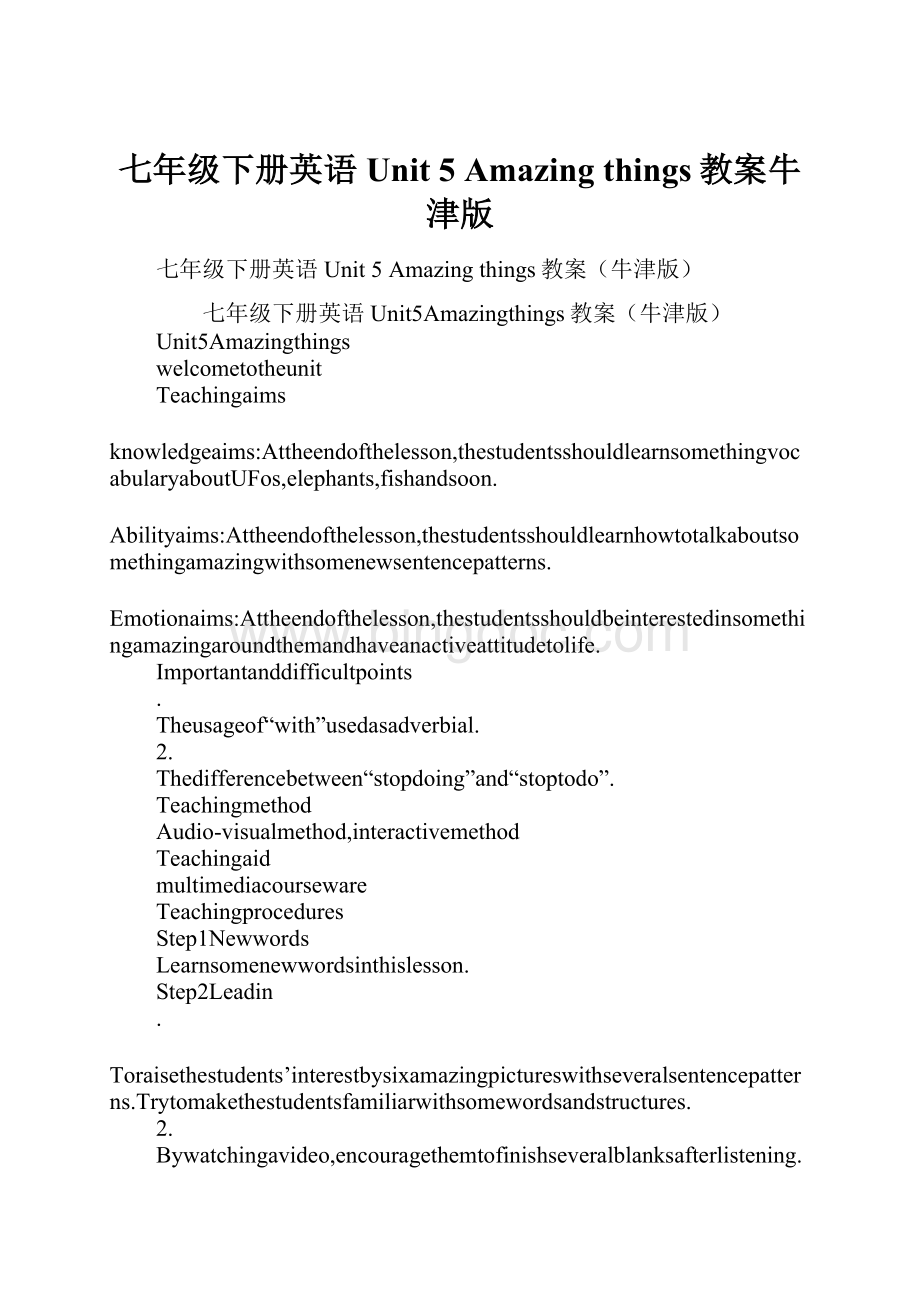七年级下册英语Unit 5 Amazing things教案牛津版.docx
《七年级下册英语Unit 5 Amazing things教案牛津版.docx》由会员分享,可在线阅读,更多相关《七年级下册英语Unit 5 Amazing things教案牛津版.docx(16页珍藏版)》请在冰点文库上搜索。

七年级下册英语Unit5Amazingthings教案牛津版
七年级下册英语Unit5Amazingthings教案(牛津版)
七年级下册英语Unit5Amazingthings教案(牛津版)
Unit5Amazingthings
welcometotheunit
Teachingaims
knowledgeaims:
Attheendofthelesson,thestudentsshouldlearnsomethingvocabularyaboutUFos,elephants,fishandsoon.
Abilityaims:
Attheendofthelesson,thestudentsshouldlearnhowtotalkaboutsomethingamazingwithsomenewsentencepatterns.
Emotionaims:
Attheendofthelesson,thestudentsshouldbeinterestedinsomethingamazingaroundthemandhaveanactiveattitudetolife.
Importantanddifficultpoints
.
Theusageof“with”usedasadverbial.
2.
Thedifferencebetween“stopdoing”and“stoptodo”.
Teachingmethod
Audio-visualmethod,interactivemethod
Teachingaid
multimediacourseware
Teachingprocedures
Step1Newwords
Learnsomenewwordsinthislesson.
Step2Leadin
.
Toraisethestudents’interestbysixamazingpictureswithseveralsentencepatterns.Trytomakethestudentsfamiliarwithsomewordsandstructures.
2.
Bywatchingavideo,encouragethemtofinishseveralblanksafterlistening.
Step3Exercises
.FinishPartA.
Lookatthepicturesandmatchthemwiththesentences.
Fishsleepwiththeireyesopen.
oureyesarethesamesizefrombirth,butournoseandearsneverstopgrowing.
TheSunisabout1,300,000timeslargerthantheEarth.
Therearenobonesinthebackofelephants’feet-onlyfat.
2.FinishPartB.
workinpairsandtalkaboutthistopicwiththewordsinthebox.Usetheconversationbelowasamodel.
Step4comicstrip
.
Askstudentstoanswertwoquestionsbylistening.
2.
Encouragethemtocompletethedialogueaccordingtothetape.
3.
Tomakethemunderstanditfullybyretellingthedialogue.
Step5Languagepoints
.comeon,Eddie.
这里comeon是语气词,表示知道某人所说的话不正确,意思是“得了吧”。
comeon还可以用于催促别人,意思是“快点,加油”。
如:
comeon,joan,orwearegoingtobelate.
琼,快点儿!
要不然我们就迟到了。
2.Fishsleepwiththeireyesopen.
这里“with+名词+形容词/介词短语”在句中作状语。
如:
)他喜欢开着窗睡觉。
2)李老师手里拿着一本书进教室。
3.TheSunisabout1,300,000timeslargerthantheEarth.
注意:
这里提及“太阳”、“地球”时,用的是theSun、theEarth。
我们再谈论天文学的各星球时,星球名称首字母均大写。
平时提及“太阳”、“地球”时,则无需大写。
如:
Theearthrevolvesaroundthesun.
地球绕着太阳转。
4.…noseandearsneverstopgrowing.
stopdoing表示停止正在做的事情,stoptodo则表示停止正在做的事情再去做另外一件事情。
如:
下课了。
让我们停下来去吃午饭吧。
别哭了,我给你讲个笑话吧。
Step6Exercises
根据句意和所给汉语提示,写出所缺单词。
.LilyandIaregoodfriends.westudyinthe______school.
2.Nooneknowsthedateofher______.
3.The______isourhome.weshouldtakegoodcareofit.
4.Thatlittleboyrodeontheelephant’s_____.
5.The_____isthathedidn’tfinishhishomeworklastnight.
6.Thisisan_______place.youcanhavealotoffunhere.
Step7Homework
makeupadialoguewithyourpartneraboutanamazingthing.
Reading
Teachingaims
knowledgeaims:
Topredictmeaningofspecificwordsfromcontext.
Topracticethemainlanguagepointsofthecontext.
Abilityaims:
Toidentifyspecificmeaningbyscanningthetext.
Tosummarizekeypointsofastorybysequencingstatements.
Toidentifykeyeventsandinfergeneralmeaning.
Emotionaims:
Toletthestudentsknowtherearenoghostsintheworld.
Importantanddifficultpoints
.Thesimplepasttense
2.Someusefulphrases
Teachingmethod
Audio-visualmethod,interactivemethod
Teachingaid
multimediacourseware
Teachingprocedures
Step1Revision
Toreviseyesterday’sdialoguebytalkingabouttheamazingpictureswithseveral
sentencepatterns.Trytomakethestudentsfamiliarwithsomewordsand
structures.
Step2Newwords
Learnsomenewwordsinthislesson.
Step3Leadin
Therearemanyghoststoriesinchinesehistory.Areyouafraid?
whatdoyouthinkaboutthem?
Doyouwanttoreadamodernghoststory?
Step4Listening
Listentothetapeandaskthestudentstoanswerthefollowingquestions
.DidmillieandAmygotoSunshineParkoneSundaymorning?
2.Didtheyhearasongfromthebushesbehindthetree?
3.whodidtheymeetontheirway?
4.whatdidAndyfindinthebushes?
Step5Reading
.Fillintheblankswiththeinformationlearned
when
where
who
what
How
2.Findthemeaningofeachwordbygivingthecorrectletter.
.Asusualmeans______.
a
thefirsttime
b
astheyoftendo
c
seldom
2.Toreplymeans______.
a
tothink
b
tosaysomethingagain
c
tosayorwritesomethingasananswer
3.Toleavemeans_____.
a
tofindout
b
tolookforc
togoaway
4.Ifyouwonder,you_______.
a
wanttoknowsomething
b
feelgreat
c
saysomethinghappily
5.Tosearchmeans_______.
a
tofindsomething
b
toshoutatsomething
c
tolookcarefullyforsomething
6.weakmeans
_____.
a
clever
bsmall
c
notstrong
3.milliewrotesomesentencesaboutwhathappened,buttheywerenotinthecorrectorder.Helpherputthesentencesintothecorrectorder.writethenumbers1-7intheboxes.
a.weranawayquickly.
b.Andyfoundalittlecatinthebushes.
c.wetalkedunderabigtreeinthepark.
d.Suddenly,weheardawhisper.
e.weturnedaroundbutsawnothing.
f.Andywenttothepark.
g.ItoldAndyaboutthestrangesound.
4.Trueorfalse
millieistellingherfriendwendyonthephoneaboutwhathappenedinthepark,butwendycan’thearherclearly.writeaTifasentenceistrueorFifitisfalse.
IwasafraidwhenIheardthewhisper.
2Thewhispercamefromabigtree.
3wewentbacktotheparkwithAndy.
4SomebodyhelpedAndyfindthe“ghost”.
5Andyfoundasmallcatinthebushes.
6AndygivethelittlecattoAmy.
5.Roleplay
workinpairs.onewillbeAndy,andtheotherwillbeareporterfromyourschoolnewsletter.Askandanswerthequestions.
.whyweremillieandAmyfrightened?
2.wheredidAndyfindthe“ghost”?
3.Howdidhefindit?
4.whydidthecatsoundlikeaghost?
5.wheredidtheytakethecat?
6.Actout
FinishthedialoguebetweenHenryandAndy
Step6Languagepoints
Explainsomeimportantlanguagepoints
)Theyturnedaroundbutsawnothing.
turnaround意为“回头,转回身”。
e.g.weturnedaroundandsawabigbirthdaycake.
我们回头看见一个大的生日蛋糕。
2)ontheirwayhome,theymetAndy.
ontheirwayhome在他们回家的路上
onone’swaytosp.译为“在某人去……的路上”。
home是副词,前面不需要加介词,如果后面跟的是名词需要加介词to。
3)“whathappened?
”Andyasked.
happen作不及物动词,意为“发生”,多指某事偶然发生或由于某种原因而产生的结果。
happentodosth.表示“碰巧或偶然做某事”,sth.happentosb.表示“某人遭遇到某事”。
例如:
whenbadthingshappen,whatshouldwedo?
当不好的事情发生时,我们应该怎么办?
Ifyouhappentoseejimmy,pleasetellhimtocometomyoffice.
要是你碰见吉米,请告诉他来我的办公室。
whydoessomethinglikethisalwayshappentome?
为什么这样的事总是发生在我身上?
4)Hesearchthebushes.
search是及物动词,后面可以直接跟宾语。
如,searchtheroom
searchmyschoolbag
如果表示目的,强调为了……而搜寻,则可以在名词前加上介词for。
如,searchformoreinformation,searchforthelostboy。
e.g.她翻遍自己所有的包找身份证。
ShesearchedallherbagsforherIDcard.
5)Andysaidtohimself.
saytooneself自言自语
thinktooneself暗自寻思,心里想
e.g.
这个老人自言自语说:
“我是多么幸运啊!
”
Theoldmansaidtohimself,“howluckyIam!
”
6)…itsoundedlikeawhisper.
soundlike听起来像
e.g.这首歌很好听。
Thesongsoundsgood.
这个低语声听起来像鬼。
Thewhispersoundslikeaghost.
苏州听起来像是一个很棒的城市。
Suzhousoundslikeagreatcity.
7)Laterthatday,theytookthelittlecattotheanimalcentre.
takesb./sth.tosomeplace意为“把某人/某物带到某处”。
e.g.IwilltakemysontoFrancetomorrow.
明天我将带我儿子去法国。
wouldyouliketohelptheteachertakethebookstotheoffice?
帮老师把书送到办公室,好吗?
8)millieandAmywereverysurprised—itwasalittlecat!
surprised可用作形容词,意为“吃惊的,惊讶的”,besurprisedtodosth.表示“某人对某事感到惊奇”,besurprisedatsth.表示“对……感到吃惊”。
例如:
IamsurprisedtoseeTomwalkintotheclassroomwithhisfather.
看到汤姆和他父亲一起走进了教室,我觉得真奇怪。
Iwassurprisedathisbehaviourattheparty.
我对他在晚会上的行为感到吃惊。
Step7Exercises
I.用所给单词的适当形式填空。
.Therearesome_______inourschool.
2.ourEnglishteachertoldustolistentotheradio________.
3.“Bequick”,Isaidto______.
4.Ifoundnothinginmyschoolbag.I
knewtherewassomething________.
5.yesterdayI______alittledoginmygarden.
6.justnowSandy______awhisperandshe____awayquickly.
II.汉译英。
.像平时一样,他早早来到了学校。
2.小偷看到警察转身就跑。
3.我确信我会学好英语的。
4.不要忘了任何重要的东西。
5.地上有个钱包。
Step8Homework
Retellthestory.
Thinkabouttheproblemthathowwetreatanimalswithouthomes.
Grammar
Teachingaims
knowledgeaims:
Torecognizeandlearnthesimplepasttense.
Abilityaims:
Fillintheblanksandmakesentencesusingthesimplepasttense.
Emotionaims:
Attheendofthelesson,thestudentsshouldbeinterestedinsomethingamazingaroundthemandhaveanactiveattitudetolife.
Importantanddifficultpoints
.Theusagesofthesimplepasttense.
2.Payattentiontothe“regularwords”&“irregularwords”.
Teachingmethod
Audio-visualmethod,interactivemethod
Teachingaid
multimediacourseware
Teachingprocedures
Step1Grammar
Usethetabletoexplaintheformandrulesofthesimplepasttense.
一、什么情况下使用一般过去时?
.weusethesimplepasttensetotalkaboutthingsinthepast.
我们用一般过去时来谈论在过去发生的动作或存在的状态。
Amonthago,millieandAmywenttoSunshinePark.
一个月前,米莉和艾米去了阳光公园。
LastSunday,theywenttotheparkagain.
上个星期天,她们又去了那儿。
2.weformthesimplepasttensebyadding‘-ed’toregularverbs.
二、规则动词过去式的构成方法
一般的谓语动词
+ed
walk—walked
2
以不发音的e结尾的动词
+d
live—lived
3
以辅音字母+y结尾的动词
变y为ied
cry—cried
4
以一个元音字母+一个辅音字母结尾的短动词
双写末尾的辅音字母+ed
stop—stopped
三、不规则动词的过去式不是加ed构成的,需要我们记住它们。
不规则动词的过去式归纳起来有这样几种类型:
与原形一样,没有变化
cost-cost
put-put
2
元音有变化
write-wrote
know-knew
3
辅音有变化
make-made
spend-spent
4
元音和辅音都有变化
leave-left
teach-taught
5
其他
am/is-was
are-were
Step2Practice
.AskstudentstofinishtheexercisesonPartA,B,c.
2.checktheanswersandlearntheimportantphrasesandsentences.
3.Tomakethemunderstanditfullybymakingthedialoguebythemselves.
4.Domoreexercisesbyfillingintheblanksandmakingsentencestopractisethesimplepasttense
Step3Summary
动词一般过去时,表示过去发生的事;
be用was或用were,have,has变had;
谓语动词过去式,过去时间做标志;
一般动词加-ed,若是特殊得硬记。
Step4Homework
.Learntheirregularverbsbyheart.
2.Dosometranslations.
Integratedskills&Speakup
Teachingaims
knowledgetarget:
Learnaboutsomeamazinganimalslikegiraffe,snake,camelsandants,thendescribethem.
Abilitytarget:
Bytheendofthisperiod,studentscantalkaboutsomeamazingthingsaboutanimalswiththesentencestructurestheyhavelearned.
Emotiontarget:
Toarousestudents’curiosity,todeveloptheirabilitytoobservethebeautyofnature,toencouragethemtoenjoylifeandstudy.
Languagepoints
T